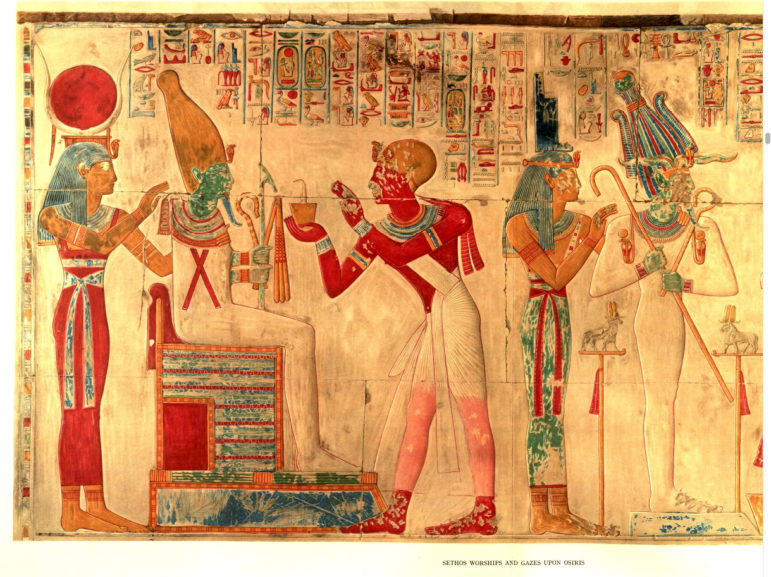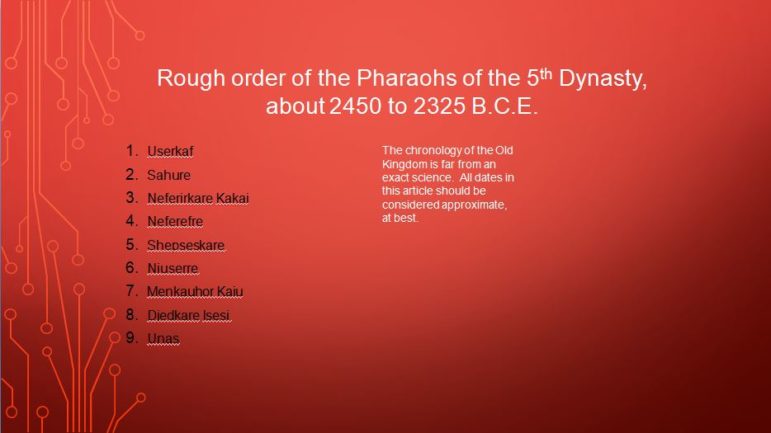TWH – A strange coincidence occurred in the Old Kingdom (3rd through the 6th Dynasty) of ancient Egypt. Textual evidence for the name of the god of the afterlife, “Osiris,” began to appear in the 5th Dynasty. Around the same time, pyramids became smaller and their quality declined. This absence of textual evidence does not indicate the absence of an active cult of Osiris. It only shows that no known record of Osiris or his Cult existed before this time.

Worship and view of Osiris; the Chapel of Osiris at Abydos Tample – Image credit: Amice M.Calverley, Alan Gardiner, 1935 – CC BY-SA 3.0
This month Archaeology Magazine: A Publication of the Archaeological Institute of America reported about the new theory of Miroslav Barta of the Czech Institute of Egyptology. All references to Barta’s theory in this article draw from that article in Archaeology. Barta’s theory links the growth of the Cult of Osiris with the rise of an administrative class in ancient Egypt which developed from managing pyramid construction. Barta argued that pyramid building nearly bankrupted Egypt.
The Wild Hunt spoke with Holli Emore, executive director of Cherry Hill Seminary to get a Pagan perspective on the new findings. She is a priestess of Temple Osireion, a Pagan tradition based on Egyptian spirituality. Powell’s article failed to impress her. While interesting, Barta’s new theory has not yet gained universal acceptance among archaeologists. It does, however, open up new ways to examine the Pagan practices of ancient Egypt.
Emore felt that the article presented conjectures without evidence. She also challenged his dating for the first mention of the name of Osiris. Scribes had “written” the Pyramid Texts on the walls of the Pyramid of Unas, the last 5th Dynasty Pharaoh. She felt that the sophistication and execution of those glyphs argued for a tradition older than their inscription.
Emore criticized Barta for failing to view Egypt through its spiritual world view. She felt that “you cannot really examine ancient Egypt without taking the spiritual culture into consideration.”
The spiritual practices of the 5th Dynasty
“Abydos, the cult center for Osiris, was also the royal necropolis as far back as we can identify kings,” Emore said. The title “pharaoh” came much later. That necropolis predated the Old Kingdom.”
She continued, “Osiris seems to have merged with a god local to Abydos (Abdju) called Khentiamentiu. Over time, you find many texts which refer to Osiris by this name, which translated means Foremost of the Westerners.”
In that period, the word “Westerners” referred to the dead.
According to Barta, Userkaf, the founder of the 5th dynasty, began the practice of building smaller pyramids and solar temples to Ra. In all, the 5th dynasty built six solar temples. At their center of those solar temples, an obelisk stood. These temples, part of an elaborate complex, celebrated the supremacy of Ra and the Pharaoh. Later pharaohs of the 5th dynasty built elaborate mortuary temples.
The Archaeology Magazine article reported that, in Barta’s theory, identifiable groups controlled different cults. The royal family controlled the Cult of Ra. That cult, in turn, glorified the Pharaoh. Pyramid building organized Egyptian society to build pyramids to guarantee the pharaoh eternal life.

This new administrative class held control over the Cult of Osiris, which offered everyone, royal and non-royal, eternal life. Anyone could take part in the Cult of Osiris. Powell quoted Barta, “We can call this a process of ‘democratization’ or widening participation in sacred affairs,” says Barta. “It was a new way to balance power.”
Emore also saw something more “democratic” in the Cult of Osiris. She said that “Osiris was a god that every Egyptian had an interest in since everyone would die at some point. His story gave hope to all, including non-royal nobility and commoners.”
The article reported the name “Osiris” first appears in the tomb of a non-royal Ptahshepses. He held titles such as “Privy to the Secret of the House of Morning” and “Overseer of All Works of the King.” His funerary monument outdid those of some members of the royal family. Ptahshepses had died during the reign of the 5th Dynasty Pharaoh, Niuserre.
The tombs of high officials in the 5th Dynasty began to become, in modern terms, status symbols. For example, the tomb of the King’s Hairdresser, Ty lived under Pharaoh Niuserre. His highly decorated tomb depicted over 1,000 people, mostly priests as well as commoners.
According to Barta, the last two pharaohs of the 5th dynasty ceased building solar temples. The royal cemetery moved back to Saqqara.
The last pharaoh of the 5th dynasty, Unas, built the smallest pyramid of the Old Kingdom. He did, however, start a new custom. Unas ordered that instructions for a funeral be inscribed on the walls of his burial chambers. Most of that text focuses on the worship of Osiris, the god of the afterlife.
This could indicate that by the end of the 5th Dynasty, the Cult of Osiris had eclipsed that of Ra. These formulas and spells spread outwards from royal tombs into those of commoners. They became known as the Pyramid Texts.
Emore disputes Barta’s model of a competition between the Cult of Ra and that of Osiris.
She said, “Osiris underwent a transformation to become Ra every night, and to emerge at dawn as Horus. It’s complicated, but you see how they blended and wove their origin myths to give meaning to whoever they might reach … The Egyptians were quite polytheistic, according each deity its proper place in their cosmology.”
Pyramids in the material world
The pharaohs of the 3rd Dynasty had experimented with pyramid building. Those of the 4th Dynasty perfected the form. They built the colossal pyramids that have survived till this day. Their construction required vast resources, a complex organization, and an administration to manage it all.

A view of the pyramids at Giza from the plateau to the south of the complex. From left to right: the Pyramid of Menkaure, the Pyramid of Khafre, and the Great Pyramid of Khufu. Image credit: Ricardo Liberato, CC BY-SA 2.0
The article reported that Barta’s theory argued that in the late 4th Dynasty this system began to break down. These colossal projects became a drain on the economy. The economic crisis of the 4th Dynasty then became a political crisis in the 5th Dynasty.
The burial practices of these two dynasties differed, which may reflect less available resources over time. Of the six Pharaohs of the 4th Dynasty, five built pyramids. The last Pharaoh of this dynasty was buried in a mastaba at Saqqara. Rectangular layers form a mastaba, and each successive layer in a mastaba is smaller than the one beneath it.
In contrast, the 5th Dynasty Pharaohs built much smaller pyramids in Saqqara and Abusir. The 5th Dynasty built 14 pyramids in the necropolis of Abusir. These 14 pyramids exhibit much lower quality than those of the 4th Dynasty at Giza. They also were smaller than those at Giza. Both members of the royal family and non-royal officials lay buried in the necropolis of Abusir. By definition, non-royals have lower status than royals. These “lower status” non-royals, however, had more lavish tombs than royals.
Emore disagrees that pyramid building bankrupted Egypt. Throughout the long history of ancient Egypt, she noted that they were always building something. She has never heard of “a record that states that they gave up pyramids because they were too expensive.”
“What is most striking to me is that this civilization lasted for so long – more than 4,000 years that we know of,” Emore continued. “We continue to discover not just new information about it, but we continue to find new meaning and context for our own times. That is both the lure and the power of ancient Egypt.”
The Wild Hunt is not responsible for links to external content.
To join a conversation on this post:
Visit our The Wild Hunt subreddit! Point your favorite browser to https://www.reddit.com/r/The_Wild_Hunt_News/, then click “JOIN”. Make sure to click the bell, too, to be notified of new articles posted to our subreddit.